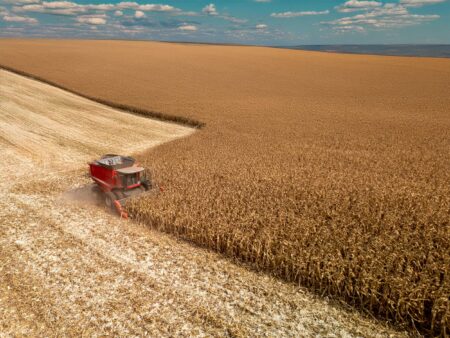By Morgan Chilson
TOPEKA — China’s plan to increase soybean and sorghum purchases moved the market in a positive direction and gave Kansas farmers a measure of relief amid high input prices and tariff challenges.
“It was great to see that America’s farmers, our soybean producers especially, were a priority in conversation last week with China,” said Kaleb Little, CEO of the Kansas Soybean Association. “Sept. 1 started that new crop year, and up until last week, China had bought zero new crop soybeans from the U.S.”
China has traditionally been the largest international purchaser of U.S. soybeans, but this year’s trade tariffs caused the country to cancel all purchases.
China buys 20–25%, or about 25–30 million metric tons, of the U.S. soybean crop in any given year, Little said. Trade agreements made in Washington, D.C., last week indicate China committed to purchasing 25 million metric tons of soybeans annually from 2026 through 2028, and this year they will buy 12 million metric tons, he said.
That leaves sales to make up this year, and Little said the soybean industry is diversifying and expanding sales to other countries. About half of U.S. soybeans are sold domestically and the other half internationally, he said.
Sorghum Crops
China also pledged to resume sorghum purchases, which Kansas State University grain economist Daniel O’Brien said on K-State’s Grain Outlook program offers potential relief to Kansas farmers who are at least able to cover production costs with current prices.
Kansas is the leading sorghum-producing state, planting 3 million acres of the grain crop, and produces a direct economic impact to the state of $686 million, according to K-State’s extension office.
“We take whatever we can get over direct costs of production for grain sorghum and then we apply it to machinery and to land and to family living,” O’Brien said. “I think the thing to watch over the next month or so will be the strength with which China would come into the sorghum market.”
If China comes into the market with enough purchases to improve prices, that could mean improved sales for Kansas farmers, who have had a good crop this year, O’Brien said.
Missing Federal Reports
The federal government regularly puts out agricultural reports on a variety of topics that help farmers make decisions and various entities track ag production.
But the government shutdown has canceled multiple reports, including crop reports that Little usually accesses to understand where Kansas soybean farmers are in their harvest. Anecdotally, he believes farmers have harvested 60–70% of their crop, which is about typical for this time of year, Little said.
In the K-State crop program, O’Brien expressed concern that lack of federal reports could affect farmers and their decision-making processes well into next year, depending on when the government shutdown ends.
For instance, information isn’t available on whether hard red winter wheat exports are strong, something usually available on a weekly basis from the U.S. Department of Agriculture, O’Brien said.
“I think we’ve no doubt had some buying, but I’d be really curious to see once we do get that information back, what the pace had continued to be during that time frame,” he said.
Even more concerning is that right now is when the USDA agricultural statistics teams would be going to field to collect samples for yields.
“They’d be sending out surveys to farmers to find out what their expectations are, what they’ve observed from their harvest numbers,” he said.
That process would have started Nov. 1, and the information would have contributed to important reports that would come out in mid-November.
But the missing data will probably “push” reports out to reports that normally occur in December.
“We typically don’t have much happening during that report, but given the different extraordinary circumstances we’re facing this year, the importance of that December report could be really heightened,” O’Brien said.
If that report is also delayed and crop production numbers aren’t available in December, O’Brien said, the uncertainty could cause crop volatility if farmers are unsure of data they use to make decisions.
Kansas Reflector is part of the States Newsroom, a network of similar news bureaus supported by grants and a coalition of donors as a 501c(3) public charity.












